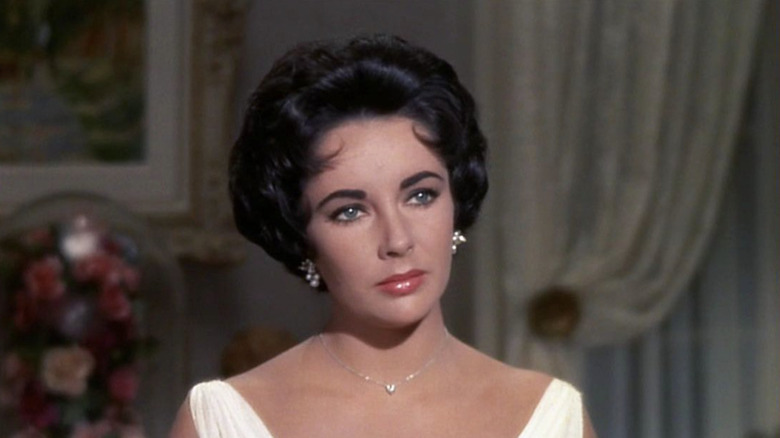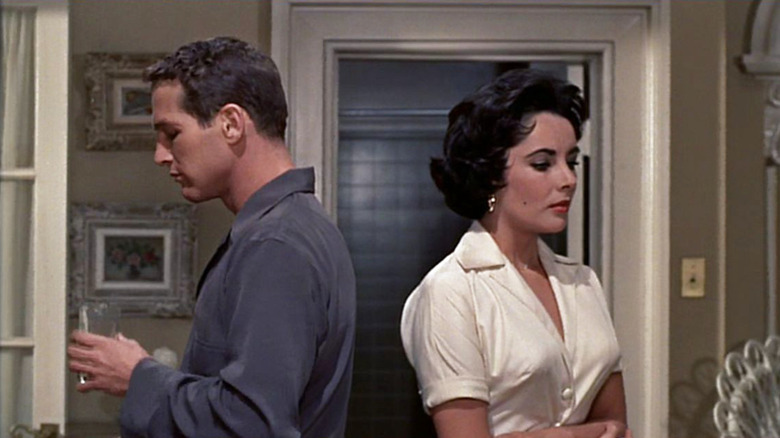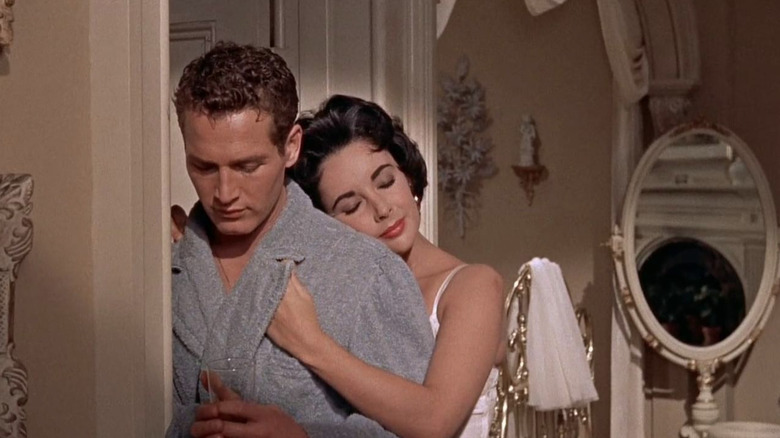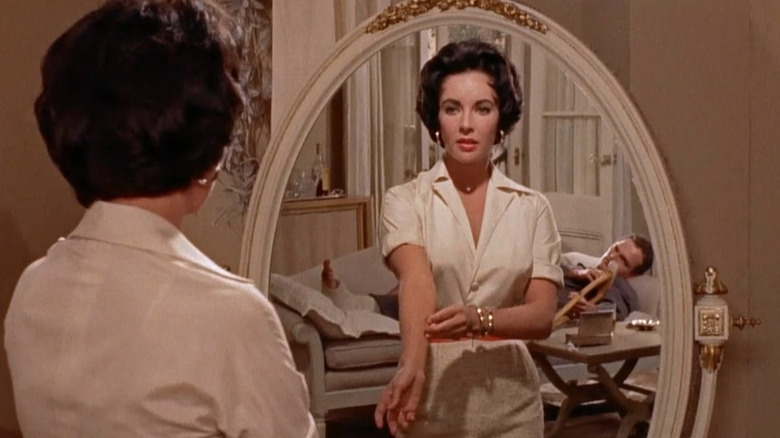Elizabeth Taylor Pushed Through Personal Tragedy To Finish Cat On A Hot Tin Roof
Elizabeth Taylor was one of the most popular leading ladies in classic-era Hollywood. With dark hair, violet eyes, and porcelain skin, Taylor's beauty was often a large part of the roles she portrayed. She played the iconic Queen Cleopatra, a lovelorn call-girl in "BUtterfield 8," and a glamorous socialite in "A Place in the Sun." Taylor's most seductive role is in "Cat on a Hot Tin Roof," but underneath the alluring exterior, she was a brokenhearted mess.
Like her cinematic performances, Elizabeth Taylor's romantic life is the stuff of legend. She was married eight times, twice to fellow actor Richard Burton, but permanent happiness remained out of reach. Burton is often thought to be the love of Taylor's life, but the premature death of another husband left Taylor devastated by grief. According to C. David Heymann's book, "Liz: An Intimate Biography of Elizabeth Taylor," the death of her third husband, producer Mike Todd, left Taylor bedridden and delayed the filming of "Cat on a Hot Tin Roof."
Behind the scenes tension
"Cat on a Hot Tin Roof" is based on a Tennessee Williams play, which won the Pulitzer Prize in 1955. The 1958 film adaptation focuses on the marriage of Brick Pollitt (Paul Newman) and Maggie (Elizabeth Taylor), which implodes after Maggie is accused of having an affair with Brick's recently deceased best friend, Skipper. The couple agrees to stay together, but Brick refuses to have any sexual contact with Maggie despite her constant pleadings. Their issues reach a breaking point during a family gathering, where the couple's miserable, childless marriage becomes a major problem for the future of Brick's family legacy.
Like the on-screen marriage, on-set relationships were shaky from the beginning. Co-stars Judith Anderson and Paul Newman both felt Taylor's performance during rehearsals was lackluster. Reportedly, Newman complained to director Richard Brooks about the unenthusiastic performance, but the director was certain the actress would "come alive" when the cameras rolled.
The director did admit the two actors had a tense relationship, saying that "as actors, they simply didn't bring out the best in one another — they didn't click. I perceived her as a charming creature, others found her to be an out-and-out spoiled brat." When Taylor refused to return to work after the loss of her husband, her relationship with the studio, Metro-Goldwyn-Mayer, also became strained.
The tragedy
Three weeks into filming, production was stopped for three days when Taylor caught a cold. During this three-day hiatus, Taylor's then-husband Mike Todd boarded a flight to New York to accept an award for Showman of the Year. She was supposed to go with her husband, but the actress' sudden illness kept her at home in bed. Todd decided to go alone, despite inclement weather and his wife's worries, and his plane crashed in New Mexico. Mike Todd was only 45 years old when he died.
Taylor was devastated by his sudden death, comparing herself to "half a pair of scissors" without Todd. Brooks was concerned the tragedy might harm his film and continue to delay production. He reported his worries to MGM, who wasted no time paying a visit to the new widow. Taylor was disgusted by the studio's selfishness, and is reported to have said, "Mike's barely cold in his grave, and all they're worried about is their god**** movie."
Like the studio, overzealous fans didn't allow Taylor space to grieve either and congregated outside Todd's funeral with snacks. After the service, the crowd surrounded the widow as she tried to leave, tore the black veil from her face, and clawed at her clothing. For a month after her husband's death, Taylor stayed in bed, heavily medicated. After encouragement from friends, the actress returned to work a month and three days after Todd's death. "Cat on A Hot Tin Roof" was completed, but the drama surrounding the film wasn't over.
Play vs. film
Playwright Tennessee Williams was the film's worst enemy. His anger was fueled by the fact that the Hays Code wouldn't allow the movie to include gay themes that were present in his original work. He was so unhappy with the film adaptation that he urged people not to see it even though he got a cut of the film's earnings.
In the play, it's suggested that Brick and Skipper were in love, but never acted on it. Brick married Maggie to hide his sexuality and Skipper tried to have sex with Maggie to prove he wasn't in love with Brick. After Skipper couldn't go through with the tryst, he committed suicide, and Brick blamed Maggie for the suicide. Brick's romantic feelings for Skipper are a much better explanation for his aversion to a physical relationship with Maggie, and it's his secret sexuality that makes him a sympathetic and relatable character.
Any mention of unexplored feelings between Skipper and Brick was wiped from the film adaptation. In Williams' defense, the erasure of Brick's sexuality from the film is a huge, story-altering change. In the movie, Brick's reluctance to have sex with Maggie became a means of punishing and controlling his wife, which transformed the character from a sympathetic victim of a homophobic society into a cruel bully. Additionally, Maggie is portrayed in the film as a desperate, abused, and neglected wife, rather than the scheming, blackmailing character in Williams' play.
Despite the changes, Todd's death, and Williams' determination to sink the movie, "Cat on a Hot Tin Roof" was a box office success and earned six Academy Award nominations. Despite the devastating loss of her husband, Taylor went on to win two Oscars and appeared in countless other successful films over the next four decades.



